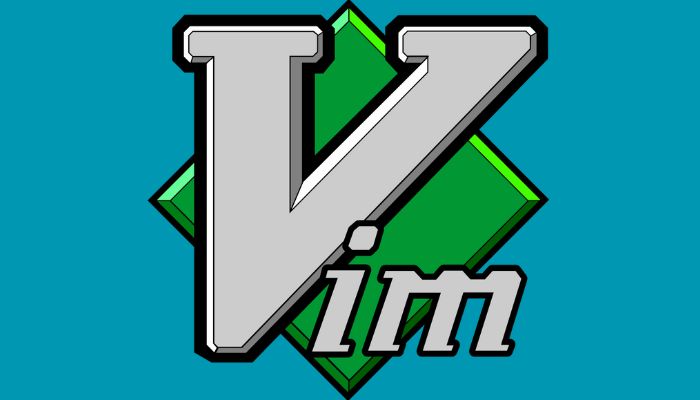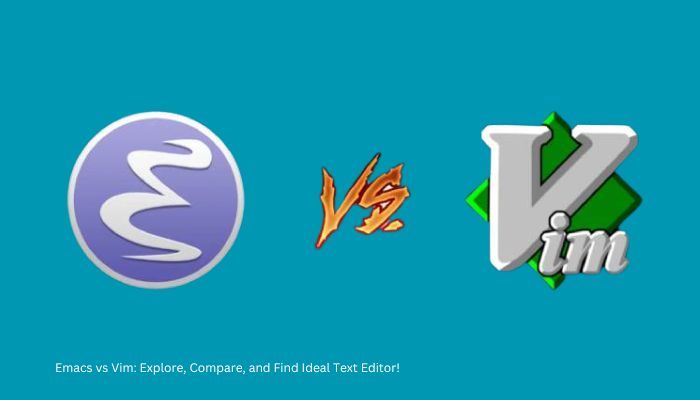Table of Contents Show
Discover the never-ending debate between Emacs and Vim with this detailed guide. Learn about the main differences, expert opinions, and important insights into these legendary text editors. Whether you’re an experienced programmer or new to coding, find out which editor fits your workflow and preferences better.
What are Text Editors?
Text editors are like digital notebooks where you can write and edit words and codes on your computer. They come in different types, from simple ones like Notepad on Windows or TextEdit on Mac to fancier ones like Atom, Brackets, or Sublime.
People who work with text and code often have strong opinions about which editor is best. Some swear by Emacs, while others are die-hard fans of Vim. There’s even a playful rivalry between users of these two editors, known as the “Editor War.”
Text editors are super helpful for programmers and writers because they let you create and change plain text files. These files can be read by other programs, like compilers or interpreters, which turn your text into something useful, like a website or a software application.
They’re especially handy when you don’t need all the bells and whistles of a full-blown development environment. With features like syntax highlighting (which makes different parts of your code stand out), auto-completion (where the editor guesses what you’re typing), and support for multiple files open at once, text editors make coding and writing a breeze.
And because they’re often free and customizable, text editors are a favorite among beginners and pros alike. Plus, they play nicely with other tools that developers use, like version control systems and build automation tools, thanks to handy plugins.
So whether you’re a seasoned coder or just starting out, having a good text editor in your toolbox is essential for getting stuff done on your computer.
What is Emacs?

Emacs is a super powerful and highly customizable text editor that’s been around since 1976. It’s kind of like the OG of text editors! Richard Stallman, the founder of GNU/Linux, released GNU Emacs in 1985, and it’s the most popular version of Emacs out there.
What makes Emacs so special is its versatility. You can tweak and customize it to do pretty much whatever you want. It’s like the Swiss Army knife of text editors!
One cool thing about Emacs is that it uses colors to highlight different parts of your text, which makes it easier to read and understand. Plus, it comes with all sorts of handy features like tutorials and documentation built right in.
Emacs supports a bunch of different languages, thanks to its Unicode support. So whether you’re writing code or prose, Emacs has got you covered.
And the best part? Emacs has a whole bunch of extensions you can add on to make it even more powerful. From email and news readers to calendars and debuggers, there’s a plugin for just about everything.
Sure, Emacs might seem a bit daunting at first, especially with its quirky terminology. But once you get the hang of it, you’ll see why it’s been a favorite among developers for over 40 years. It’s like having a loyal sidekick that’s always there to help you get stuff done.
What is Vim? (Vi Improved)

Vim, short for “Vi Improved,” is a powerful text editor introduced in 1991 as an enhanced version of the older Unix text editor, Vi. It’s a staple tool for Unix-based systems like Linux, BSD, and macOS, often coming pre-installed. Vim is renowned for its speed, efficiency, and robust features, making it a top choice for system programmers, administrators, and developers alike.
What sets Vim apart is its keyboard-centric approach to text editing. Users navigate through different modes, including:
1. Normal mode: For moving around and executing commands like find, redo, and replace.
2. Command mode: Where every keystroke functions as a command affecting the edited text.
3. Insert mode: For typing and adding text to the file.
4. Visual mode: For highlighting or selecting text.
This modal approach might seem complex initially, but it evolves into a potent skill once mastered, allowing for efficient text manipulation and editing.
There are several reasons why Vim has garnered such a dedicated following:
1. Ubiquity: Vim is widely available across various Unix-based systems, ensuring consistency and familiarity for users across platforms.
2. Scalability: It can serve as a simple configuration file editor or a comprehensive writing environment, adapting to diverse use cases.
3. Efficiency: Vim boasts a shallow memory footprint and is designed for speed, making it ideal for resource-conscious environments.
4. Command-centered design: With a few well-learned commands, users can perform complex text-related tasks quickly and efficiently.
5. Customizability: Vim’s extensive configurability allows users to tailor the editor to their preferences, utilizing simple text files to store settings.
Despite its steep learning curve and unconventional interface, Vim’s versatility, speed, and customizable nature make it a favorite among those who value efficiency and control in their text editing workflows.
Emacs vs Vim: Similarities Between Vim and Emacs
Before delving into the differences between Vim and Emacs, it’s worth noting some key similarities shared by these iconic text editors:
Cross-Platform Compatibility: Both Emacs and Vim are cross-platform text editors, meaning they work seamlessly on various operating systems such as Linux, Unix, and Microsoft Windows. This versatility allows users to enjoy a consistent editing experience across different platforms.
Support for Command-Line and GUI Interfaces: While they now offer graphical user interfaces (GUIs), both Emacs and Vim originated as command-line-based applications. This heritage contributes to their efficiency and aligns with the Unix philosophy of focusing on simplicity and modularity. Users have the flexibility to choose between the command-line interface or the graphical interface based on their preferences and workflow.
Buffer Tabs: Both editors provide support for buffer tabs, allowing users to manage multiple open files efficiently. Whether working in the command line or GUI mode, users can organize their workspace by easily switching between different buffers or files.
Active Communities and Documentation: Both Emacs and Vim boast vibrant communities and extensive documentation. Whether you’re a beginner seeking guidance or an experienced user exploring advanced features, you’ll find a wealth of resources, tutorials, and forums online. This strong community support ensures that users have access to assistance and insights to enhance their editing experience.
Multi-Language Support: Vim and Emacs are available in multiple languages, catering to a diverse global user base. Whether you prefer English, Chinese, Polish, Russian, Italian, French, or another language, you can typically find localization options for these editors.
Despite their differences in design philosophy and user interface, Vim and Emacs share these fundamental traits, which contribute to their enduring popularity and widespread adoption among developers and text editing enthusiasts worldwide.
Emacs vs Vim: Differences Between Emacs and Vim
When comparing Emacs and Vim, several key differences become apparent, influencing user experience, productivity, and customization:
1. User Interface:
– Vim employs distinct editing modes like command mode and insert mode, aiming to minimize keystrokes.
– Emacs uses modifier keys for shortcuts, often requiring simultaneous key presses for a single function, a design aspect criticized by some users.
2. Ease of Learning:
– Vim has a steep learning curve due to its various editing modes and unique commands, but proficient users often find it highly advantageous for speed and productivity.
– Emacs is relatively easier for beginners due to consistent keybindings and a more natural interface, coupled with comprehensive documentation.
3. Customization and Extensibility:
– Emacs offers extensive customization, allowing users to choose from various macros and automate tasks, enhancing workflow efficiency.
– Vim offers less customization but can be extended through its configuration file, plugins, and keybinding adjustments.
4. RAM Usage:
– Vim is lightweight and consumes less memory compared to Emacs, which has garnered criticism for its resource consumption.
– Emacs can mitigate RAM usage by running a single persistent process supporting multiple clients, reducing startup time and overall memory usage.
5. Editing Speed and Productivity:
– Vim’s modal interface enables efficient text manipulation with fewer keystrokes, contributing to faster editing and increased productivity.
– Emacs users may find themselves typing several shortcuts for functions, potentially slowing down the editing process, though customization can enhance productivity.
Despite these differences, both Emacs and Vim have their dedicated user bases and excel in various aspects of text editing and workflow management. The choice between them often boils down to individual preferences, workflow requirements, and the extent of customization desired by the user.
Detailed Comparison Table (Emacs vs Vim)
| Criteria | Emacs | Vim |
| Ease of Use | Steep learning curve. | Also has a learning curve. |
| Customization | Customizable with Lisp. | Configurable with scripts, but less extensive than Emacs. |
| Resource Usage | Requires more resources. | More lightweight. |
| Community Support | Large community with extensive documentation and add-ons. | Strong community with extensive plugins and support. |
| Programming Languages Supported | Supports a wide range of programming languages. | Supports a wide array of programming languages. |
| Built-in Tools | Has a wide range of integrated tools. | Less built-in functionality, relies more on plugins. |
| Operating System Compatibility | Supports a wide range of programming languages. | Supports a wide range of programming languages. |
Expert Opinion on Emacs vs Vim
After consulting experienced programmers and industry experts, it’s evident that the Emacs vs Vim debate is nuanced and multifaceted. Here’s a distilled view of their insights:
Adaptability and Learning Curve:
Both Emacs and Vim present steep learning curves, but they offer significant rewards once mastered. Emacs is praised for its adaptability, boasting extensive customization capabilities. In contrast, Vim’s learning curve is more about achieving efficiency in text manipulation.
Efficiency and Workflow Integration:
Many seasoned programmers appreciate Vim’s efficiency, particularly its modal editing, which accelerates text editing tasks. Emacs, on the other hand, shines in workflow integration, serving as a comprehensive solution for coding, email, calendar, and more.
Community and Ecosystem:
Experts unanimously agree that both editors boast vibrant communities. However, Emacs’s community stands out for its relentless focus on expanding the editor’s capabilities. Vim’s community, meanwhile, is dedicated to refining and optimizing the core editing experience.
Use Case Suitability:
The choice between Emacs and Vim often hinges on specific use cases. Emacs, with its extensive feature set, appeals to those who prefer a unified development environment. On the other hand, Vim’s versatility makes it a preferred choice for individuals needing a potent editor that seamlessly integrates into various environments and workflows.
While both Emacs and Vim have distinct advantages and loyal followings, the decision between them ultimately rests on individual needs, project requirements, and the willingness to embark on a learning journey. Therefore, whether Vim or Emacs is the right choice is a deeply personal decision.
FAQ
**Is vi faster than Emacs?**
Yes, vi is generally considered faster than Emacs, particularly in terms of startup time and performance on systems with limited resources. Its lightweight design prioritizes speed and efficiency, making it a preferred choice for tasks requiring quick loading and minimal memory usage.
**Should I learn Emacs if I know Vim?**
Certainly! Learning Emacs after mastering Vim can be beneficial. Emacs offers a broader perspective on text editing and development environments. With its extensive customization options and integrated tools, Emacs can complement the skills acquired from Vim, enhancing your overall development experience.
**Can you use Vim in Emacs?**
Absolutely! You can use Vim within Emacs using packages like “Evil mode.” This package emulates Vim’s key bindings and modal editing features within Emacs. By utilizing Evil mode, users can enjoy Vim’s editing efficiency while still taking advantage of Emacs’ extensive features and customization options.
Conclusion
The debate between Emacs and Vim is not just about choosing a text editor but embracing a philosophy of text editing. While Emacs offers unparalleled adaptability and integration, Vim excels in efficiency and speed. Both editors have vibrant communities and cater to different preferences and workflow requirements.
Ultimately, the decision between Emacs and Vim is deeply personal and depends on factors such as individual needs, project requirements, and the willingness to invest time in learning. Whether you choose Emacs for its versatility or Vim for its speed, both editors empower users to craft their ideal editing experience.
So, whether you embark on the Emacs journey or embrace the Vim way, rest assured that you’re choosing a tool that aligns with your unique workflow and preferences. Happy editing!












